
Introduction
Welcome to our guide on smart grid integration and the role of vertical turbines in the energy landscape. As our world becomes increasingly dependent on renewable energy sources, it is essential to explore innovative ways to harness and integrate these sources seamlessly. In this article, we will discuss the concept of smart grid integration and how vertical turbines can enhance the overall efficiency and reliability of the energy grid.
What is Smart Grid Integration?
A smart grid is an advanced electricity network that uses digital communication technology to monitor, control, and optimize the flow of electricity. It enables two-way communication between the energy provider and consumers, allowing for more efficient energy usage, improved reliability, and better integration of renewable energy sources.
Smart grid integration involves connecting various renewable energy sources, such as solar and wind, to the grid and effectively managing their power generation. This integration ensures that the energy produced by these sources is balanced with the overall demand, resulting in a more stable and sustainable energy system.
The Role of Vertical Turbines in Smart Grid Integration
Vertical turbines, often referred to as vertical axis wind turbines (VAWTs), offer unique advantages when it comes to smart grid integration. Unlike traditional horizontal axis wind turbines (HAWTs), vertical turbines are designed to operate in urban areas and can harness wind energy from all directions.
1. Space Efficiency
Vertical turbines have a smaller footprint compared to HAWTs, making them suitable for urban environments where space is limited. These turbines can be installed on rooftops, car parks, and other vertical structures without requiring large tracts of land. This space efficiency allows for more decentralized power generation, which aligns perfectly with the concept of a smart grid.
2. Noise and Visual Impact
One of the common concerns with wind turbines is the noise they produce and the visual impact they have on the surrounding landscape. Vertical turbines, being smaller in size and often mounted on taller structures, generate less noise and have a reduced visual impact compared to their horizontal counterparts. This makes them more suitable for residential and commercial areas.
3. Flexibility in Installation
Vertical turbines can be installed at various heights and in different locations due to their design. This flexibility allows them to capture wind energy even in complex urban environments where the wind direction is variable due to the presence of buildings and other structures. By utilizing vertical turbines, the smart grid can tap into wind resources where they were previously inaccessible.
4. Combined Power Generation
The integration of vertical turbines into the smart grid offers an opportunity for combined power generation. Alongside other renewable sources like solar panels, vertical turbines can contribute to a diversified and resilient energy mix. Even in areas with lower wind speeds, the combination of different renewable sources can ensure reliable and continuous power supply.
Conclusion
Smart grid integration is crucial for creating a sustainable and efficient energy landscape. Vertical turbines play a vital role in this integration by offering space efficiency, reduced noise and visual impact, installation flexibility, and opportunities for combined power generation. By harnessing wind energy through vertical turbines, the smart grid can further enhance its ability to balance power supply and demand, ultimately leading to a greener and more reliable energy future.
